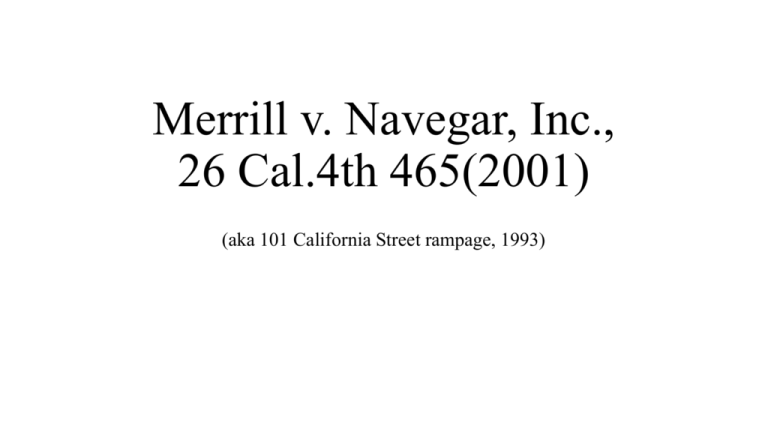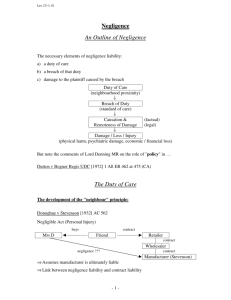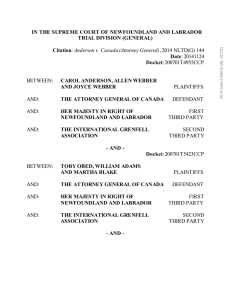Merrill v. Navegar, Inc., 26 Cal.4th 465(2001)
advertisement

Merrill v. Navegar, Inc., 26 Cal.4th 465(2001) (aka 101 California Street rampage, 1993) Factual Background • 55 year old Gian Luigi Ferri • 2 TEC-DC 9 & Norinco Model 1911A1 Automatic Made Easy! Issue: • Whether, in the absence of a special relationship, the victim of a shooting may state a claim against the manufacturer of a legal and non-defective gun based on breach of a claimed duty to use due care not to increase the risk beyond that inherent in the presence of firearms in our society; and, if so, • Whether plaintiff's evidence raised a triable issue of causation. Plaintiffs’ Causes of Action • Common Law Negligence • Negligence Per Se • Strict Liability for Negligent Marketing & Ultrahazardous Activity Common Law Negligence Plaintiffs claimed . . . Navegar knew or should have known that • TEC-9 is more of a military assault weapon. • Has no legitimate sporting or self defense purpose. • Owed them the legal duty of not manufacturing and/or distributing TEC-9 because it had no legitimate use other than the killing of human beings. Negligence Per Se • plaintiffs alleged that Navegar violated the Roberti-Roos Assault Weapons Control Act of 1989 (“AWCA”) (see Pen.Code, §§ 12275.5, 12276) by advertising the TEC-9 in California and that this advertising "was the direct and legal cause in bringing about plaintiffs' injuries" because it "was a substantial factor in causing Ferri to acquire" the Navegar weapons he used. • Plaintiffs' evidence failed to create a triable factual issue as to whether the advertisements influenced Ferri to purchase TEC-9. Strict Liability for Negligent Marketing & Ultra-hazardous Activity Plaintiffs must prove that . . . • A defect caused injury. • The defect in the product was due to negligence of the defendant in either design or manufacture of a product. • The product failed to perform as safely as a consumer would expect. • The benefits do not outweigh the risk of danger. Rule: California Civil Code §1714.4 • . . . The design, distribution, or marketing of firearms and ammunition is not exempt from the duty to use ordinary care and skill that is required by this section. The extent of liability in these cases is defined by the Title on Compensatory Relief. • Encompassed both negligence and strict liability theories in products liability cases. • Would have blocked a negligent distribution claim because, according to the majority, such a claim necessarily depends on a consideration of the risks and benefits of the weapon's design features. Analysis\Application • Navegar has `shown that one or more elements of the cause of action, even if not separately pleaded, cannot be established,' the burden shifts to the plaintiff to show the existence of a triable issue; to meet that burden, the plaintiff `may not rely upon the mere allegations or denials of its pleadings . . . but, instead, shall set forth the specific facts showing that a triable issue of material fact exists as to that cause of action . . . .' (See, Stevens v. Parke, Davis & Co. (1973) 9 Cal.3d 51, 107 Cal. Rptr. 45, 507 P.2d 653 (Stevens)). • In order to prevail on a negligence claim, Plaintiff must show that Defendant owed her a legal duty, breached that duty and that the breach was a proximate or legal cause to her injury. Conclusion: • The Court concluded the trial court properly granted Navegar summary judgment. • In section 1714.4, the Legislature had set California's public policy regarding a gun manufacturer's liability under these circumstances. Given that public policy, plaintiffs may not proceed with their negligence claim. • The judgment was for Navegar.







